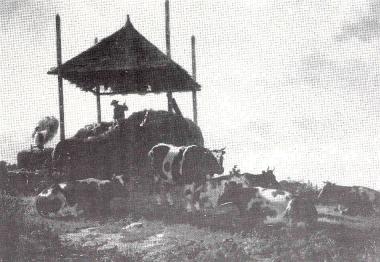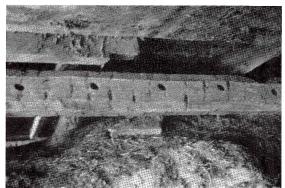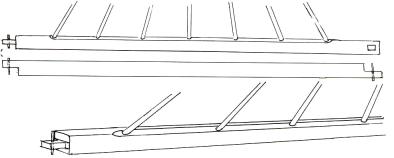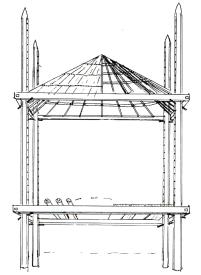|
Dutch
Barn Preservation Society
Dedicated
to the Study and Preservation
of New World Dutch Barns
NEWSLETTER,
FALL 1989, VOL. 2, ISSUE 2
The
Hay Barrack: A Dutch Favorite

"The
Van Bergen Farm," ca. 1733, oil on boards, near Leeds, Greene
County, NY. Attributed to John Heaton (working ca. 1730-45). New
York State Historical Association, Cooperstown.
By
Roderic H. Blackburn and Shirley Dunn
The hay barrack,
long an indispensable part of Hudson Valley agrarian life, stood
adjacent to the Dutch barn on the farmsteads of the Dutch and their
descendants. The hay barrack, hooi-berg in Dutch, is a
farm structure constructed of vertical poles set in the ground
at equal Intervals. The poles support a movable thatched roof under
which hay or other crops can be stored. This outbuilding is primarily
associated with Dutch farm here and in the Netherlands, and In
the region south-east of the Zuider Zee in the Netherlands the
hay barrack is still widely used. Hay barracks have been reported
in other European countries including Germany, France and Italy.
Dutch manuscript maps and illustrations dating to the 16th century
show hay barracks as common farm structures. A search of earlier
documents would probably place the barracks' origin centuries earlier.In
Dutch colonial America, hay barracks were an important part of
the identity of a Dutch farm. Kiliaen Van Rensselaer, the first
patroon of Rensselaerswyck, wrote of a farm near present Albany, "the
aforesaid persons had in the year 1631 established two fine farms
. . . provided with a convenient dwelling . . . in addition two
hay barracks, each of five poles fifty feet high . . ." (Van
Laer 1908:308) and hay barracks are illustrated on the farms shown
on his 1632 manuscript map of Rensselaerswyck. On Manhattan in
1632, a farm inventory includes
"1 barrack with seen . . . containing 80 schepels of rye
and wheat"
(Van Laer 1908:192). Many more hay barracks are listed in American
farm inventories and other documents for the next two centuries.
Hay barracks continued to be an important adjunct of farms into
the 20th century in New York and New Jersey and were also built
by the Germans in Pennsylvania. Newspaper ads prior to 1730 indicated
that barracks had been adopted by non-Dutch families; the structure
eventually spread to such widely dispersed areas as Western New
York, Maryland, Massachusetts, Virginia, Ohio, and Canada's Prince
Edward Island (Walker 1973:42,44). A few hay barracks, probably
dating from this century, still survive in New Jersey and on
Long Island. Parts of older barracks have been found incorporated
into existing houses and barns or stored in barns. In early New
York the four-post barrack was common, although mention of five-
and six-pole barracks can be found. Romer's 1690's plan of Schenectady,
(Public Record Office, London), shows four pentagonal outlines,
probably five-post barracks. A 1638 Flatlands (Brooklyn) farm
inventory mentions "1 hay rick, with five posts, 40 feet
tall"
(Reg. of Provo Sect. 1638-42). The hay barracks depicted in the
1730's painting of the Van Bergen farm (see illustration) are
six poles each. An extensive description of hay barracks and
their use is contained in the journal of Peter Kalm, a Swedish
naturalist, who traveled through the northern colonies in 1749-50.
He wrote with the eye of a careful observer of the social as
well as the natural scene. "When the people wanted any hay,
they cut some of it loose, by a specially made cutter. However,
many people. . . had haystacks with roofs which could be moved
up and down. Near the surface of the ground were some poles laid,
on which the hay was put, that the air might pass freely through
it. I have mentioned be fore that the cattle had no stables in
winter or summer and were obliged to graze in the open air during
the whole year. However, in Philadelphia, and in a few other
places, I saw that those people who made use of the latter kind
of haystacks, viz. that with movable roofs, commonly had built
them so that the hay was put a fathom or two above the ground,
on a floor of boards, under which the cattle could stand in winter
when the weather was very bad. Under this floor were partitions
of boards on all the sides, which however stood far enough from
each other to afford the air a free passage" (Kalm 1964:264).
Another writer who described a hay barrack was Alexander Coventry,
a Scotsman in Dutch-American territory. In his 1788 diary entries,
Coventry (in Columbia County, NY) described building a barrack
for which he cut six trees. He used 28 pine trees for the spars,
cut hoops for the top of the roof, tied on the lathes (over the
spars) and laid about two rounds of thatch. When he encountered
difficulty raising the roof without iron pins, he then borrowed
a "barrack lever" (Coventry 1978:200-204).
An excellent
and detailed painting of a hay barrack in use in the mid-part
of the 19th century was done by William T. Ranney of New Jersey
(see illustration). This accurate painting is probably one of
an actual New Jersey barrack. Typically it measured about 16'
on each side and 25' high. That the poles are squared, that there
are seven spars to a plate and they are set into angled holes
conforms to existing barrack remnants. It is not clear whether
the plates meet in a mortise or lap joint but the pins which
hold them up are visible in the near posts. The holes in the
posts are rather widely separated. Note the use of cross spars
and the layering of thatch.
 "Haying
Time" 1856 (detail), oil on canvas by William Tylee Ranney
(1813-1857), New Jersey or New York, 1856. Photo courtesy of
Christie's, New York. "Haying
Time" 1856 (detail), oil on canvas by William Tylee Ranney
(1813-1857), New Jersey or New York, 1856. Photo courtesy of
Christie's, New York.
With fat cows contentedly lying about, the correspondence to
Netherlands' 17th century painting is evident. The artist demonstrated
that in some places in New Jersey, Dutch farm culture was still
alive one hundred years ago.
Mary Capner, of Hunterdon County, NJ, confirmed paintings and
documentary sources. She wrote in 1787, "Barracks are a building
I have not described to you/ tho I noticed them at the first coming
into the country. Tommy has made one for his Bro. [It has] four
poles fixed in the ground at the distance of fifteen feet in a
square. The poles are squared fifteen feet or more at the top and
five feet at bottom unsquared. This is all above ground. In the
square part of the poles there are holes bored thro at the distance
of twelve inches big enough for a strong iron pin to put thro to
support four wall plates which are tenanted at the ends, then some
light spares are put upon the wall plates and thatched upon them.
When it was only five feet above the ground, the roof can be raised
at pleasure 21 feet or any distance from the ground between that
and five feet. These are to put hay or any kind of grain under
and the roof is al ways ready to shelter it from hasty rains which
is common here in summer. Those that have only two cows have the
bottom part boarded at the sides and a floor laid over and the
hay at top and the cows stable under."
(Schmidt 1945:95) .
A tangible way of learning about hay barracks is from surviving
pieces of old barracks. Reproduced here are drawings from three
recently discovered barrack roof plates now used as ceiling joists
in a farm house near Albany, NY. Also shown is a pole reused as
a floor joist in a Dutch barn in Ghent, Columbia County, NY, and
a photograph of a reused barracks pole in a barn in South Bethlehem,
Albany County, NY. Other hay barrack parts have been found elsewhere.
In most cases, the parts came from former barracks incorporated
into their present locations in the 19th century. It is likely,
therefore, that the parts came from barracks originally made in
the first part of the 19th century or possibly earlier. Because
of the rarity and age of these barracks parts they warrant some
discussion.
The three roof plates were found in the kitchen wing of a house
on Fredericks Road, Guilderland Center, NY. The plates (see illustrations)
are square in section, 7"x 7", and were shaped by a hewing
ax but not smoothed with an adze. Each is chamfered on one edge.
Along this edge seven holes, each 2" in diameter and 4 1/2" deep,
have been drilled part way through the plate. The original length
of the plates and the angle of the roof can be calculated by the
remaining holes and their angles. Originally the roof plates were
about 24' long. Seven spar holes are 35"
apart center to center with 27" on each end beyond the center
of the last holes. The spar holes were drilled at increasingly
acute angles from the center hole (which is at 90° to the plate)
so that the spars would meet at the apex of the roof. Cut nails
(19th century) remain in each hole where they secured each spar.
The nails are probably not original, since three other barrack
plates in a nearby barn have no evidence of nailing. The angle
of each hole to the plate establishes the convergence of the spars,
and the angle of all holes to the horizontal surface of the plate
establishes the roof angle.
The barracks' reconstruction on paper hypothesizes a roof in
which the longest (outer) spars were 205" long (including
4 W' in the hole), and the center or shortest one was 175" long.
The angle to the surface of the plate was about 34° above horizontal.
This estimate proves correct when drawn out with spars 175" long;
the spars intersect when set at about 35 degrees.
Given a barrack height-to-width ratio of 10/6 (average for most),
then this barrack (with plates 24' long and thus poles on center
about 18') was about 30' high. A pole found under the Skinkle-Schrom
Dutch barn visited on a Columbia County Dutch Barn Preservation
Society tour in 1988 was 20' long and showed evidence of having
been once perhaps 2 feet longer (plus what-ever was in the ground).
It was ax-hewn to octagonal shape in section, tapering from 8 to
6" wide, with holes every 12 1/8". It was evidently cut
off while standing. The pole showed the weathering of long use,
as the holes were worn out of shape by the iron rods. These holes
were probably originally 1 %" diameter. The top, soft with
rot, may have lost four inches as the first hole was only eight
inches from the end. The pole appeared to be made of oak. At the
time it was examined, the first hole was 43" above the bottom
of the pole. Including the lost 24", the first hole would
have been about 67" above the ground when the pole was new.
The adjoining Dutch stone house has features which indicate it
was built ca. 1760-90. Presumably the five-bay Dutch barn may be
of the same age. Therefore, the barrack may be 18th century.
The octagonal shaping of the pole is elegant and unique. Was
the shaping for style or function? On an octagonal barrack such
a pole would fit snugly against the adjoining plates. But so large
a barrack as an octagonal one is not known for New York or New
Jersey. The pole shape would fit well enough with a four post barrack,
also. All other New World evidence points to squared poles; however,
the later barracks which have been found standing in the present
century, and likely dating from this century, contain round poles.
 <-Octagonal
hay barrack pole from the Skinckle-Schrom barn, Ghent, NY. Photo
by Roderic Blackburn. <-Octagonal
hay barrack pole from the Skinckle-Schrom barn, Ghent, NY. Photo
by Roderic Blackburn.

 
Hay barrack plate after originals in house in
Guilderland Center, Albany County, NY, shows reconstruction of
full 24' length with spars, and the same, shown at an angle.
Section of plate showing spar hole and spar (left) and conjectural
reconstruction of plate joining and octagonal pole holding plates
with iron rod.
Newsletter, Fall
1989, part two
|